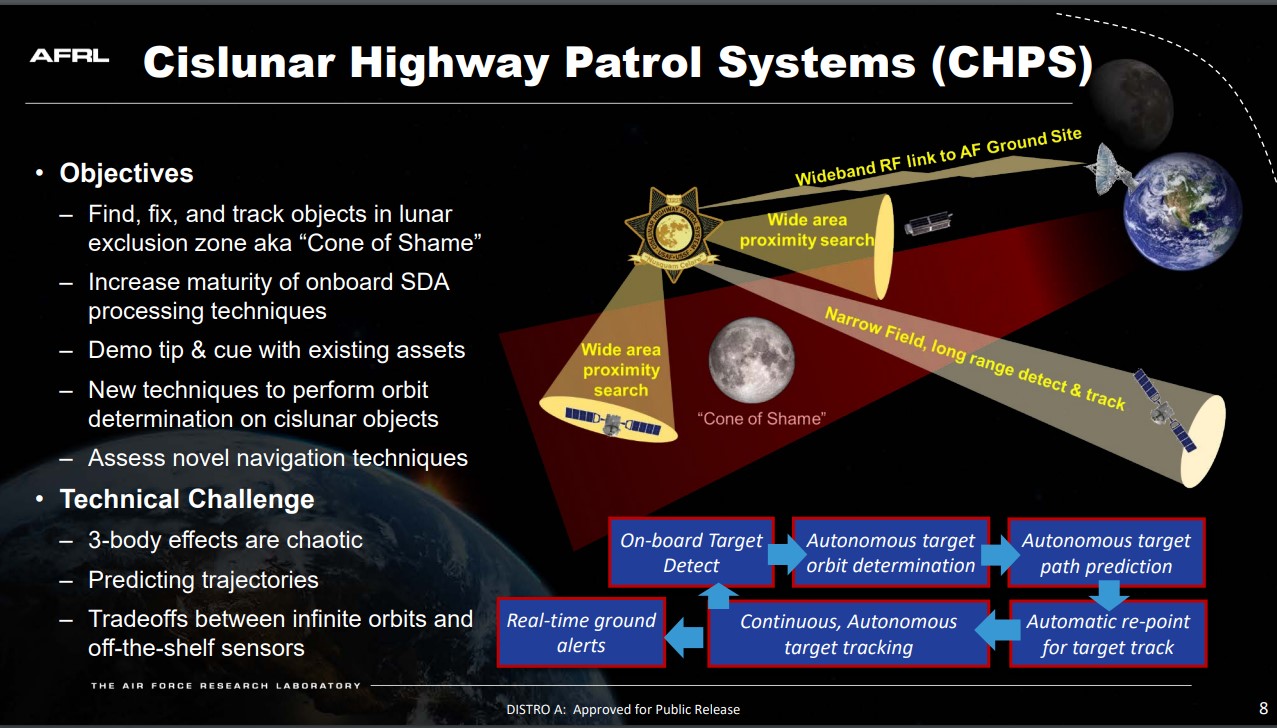In a bid to increase its capabilities in space, the US military is working on a satellite that will allow it to patrol around the far side of the moon.
The Space Vehicles Directorate of the Air Force Research Laboratory (AFRL) announced on March 21 that it is looking for partners to develop the Cislunar Highway Patrol System (CHPS) satellite.
The CHPS is intended to offer space domain awareness beyond geosynchronous orbit, in an area of the moon where activity is increasing. The AFRL has invited companies that are part of the Space Enterprise Consortium (SpEC) to submit proposals by April 1, 2022.
“The CHPS program will deliver space domain awareness, in a region that is one thousand times greater than our current area of responsibility,” said Michael Lopez, CHPS program manager. “AFRL is interested in hearing from companies that may have ideas that differ from ours, and could contribute to the satellite’s capabilities.”

The CHPS is a spacecraft devised by the AFRL’s Space Vehicles Directorate to increase the US Space Force’s potential to detect, monitor, and identify artificial objects functioning at distances beyond a range of 385,000 kilometers.
“We are looking forward to seeing what the industry will propose, to help us design and build the system,” said Lopez. ”Our goal is to create a satellite that will become critically important as the US supports civil and commercial efforts in the Cislunar domain.”
Cislunar Highway Patrol System
Earlier this month, AFRL released a video on YouTube revealing that the US military is planning to increase its reach in space using a new patrolling system. The CHPS would be developed to enhance the US Space Force’s capability to monitor and identify man-made objects in the moon’s orbit and beyond.
The moon-patrolling spacecraft will be sent into cislunar space, which is the moon’s far side. The video illustrates how the US is expanding its reach in space from 35,400 kilometers.
“The Air Force Research Laboratory is extending that range by 10 times and the operations area of the United States by 1,000 times, taking our reach to the far side of the moon into cislunar space, far beyond the crowd”, the video states.
Stating that the US Space Force will maintain the peaceful development of space, the AFRL says in the video, “The responsible use of space and unfettered access to space domain awareness ensures collision avoidance, on-orbit logistics, communication, navigation and maneuvering, all critical to the United States and allied space commerce, science, and exploration.”
While the video addressed many things, it still leaves a lot of questions unanswered concerning the system’s specific characteristics.
AFRL’s fact-sheet contains minimal technical facts on the system, including no information about the satellite’s design, endurance, or budget. The spacecraft, however, will utilize a combination of wide-field and narrow-field sensors to locate and track objects and deliver location updates on spacecraft operating near the moon after its launch in 2025.

Previously, Col. Eric Felt, chief of AFRL’s Space Vehicles Directorate, portrayed CHPS as a “straw man” aimed at stimulating new ideas from industry on how to monitor and safeguard the lunar exclusion zone.
US Space Force
The US Space Force was established on December 20, 2019, when the Trump administration passed the National Defense Authorization Act. USSF is the sixth branch of the US Armed Services, and also the first new military service since the Air Force was created in 1947.
“Space is the world’s newest war-fighting domain,” Trump had said during the signing ceremony. “Amid grave threats to our national security, American superiority in space is absolutely vital. And we’re leading, but we’re not leading by enough. But very shortly we’ll be leading by a lot.”
The idea of the US Space Force may have its origin in the Air Force Space Command (AFSC), which was founded in 1982. During the Cold War, AFSC’s mandate was to increase America’s space edge, especially through the launch of powerful military satellites.
The Space Command was instrumental in the development of the Global Positioning System (GPS), which boosted America’s ability to detect missile launches and track military activities throughout the world.
Sharing a similar vision, the fundamental goal of the United States Space Force is to maintain, protect, and expand the fleet of sophisticated military satellites, which serve as the core of US global military activities. Satellites are extremely crucial for any country in the 21st century.
At the same time, satellites are particularly vulnerable to a number of attacks, making America’s reliance on them a significant weakness that might jeopardize its military activities across the world. China, in particular, has capitalized on this weakness by amassing an array of anti-satellite missiles and technology, besides resorting to cyber-attacks. Finding ways to protect satellites is the Space Force’s most challenging mission in order to preserve America’s space dominance.
Furthermore, when the competition to exploit the moon’s resources heats up, the USSF would play a critical role in preserving the country’s interests. In 2020, Maj. Gen. John Shaw, then-head of Space Operations Command, said that Space Force troops would deploy command centers “somewhere in the lunar environment” in the coming years.
However, Space Force officials promptly dismissed the remark, with vice commander Lt. Gen. David Thompson stressing that any such development would be decades away.
- Contact the author at ashishmichel@gmail.com
- Follow EurAsian Times on Google News




